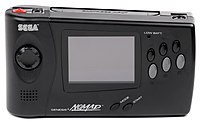Genesis Nomad
 | |
| Manufacturer | Sega |
|---|---|
| Type | Handheld game console |
| Generation | Fifth generation era |
| Lifespan | October 13, 1995 |
| Units sold | 1 million[1] |
| Media | Cartridge |
| CPU | Motorola 68000 |
| Predecessor | Sega Game Gear |
The Sega Nomad (also called Sega Genesis Nomad or just Nomad) was a handheld game console sold for the North American consumer market which played Mega Drive/Genesis game cartridges. The system was similar to the Japanese Sega Mega Jet, but featured a built-in color screen; the Mega Jet needed a separate monitor. The Nomad was never officially released in PAL territories such as Europe and Australia, though the unit retained its PAL/NTSC switch on the internal board.[2] It was released in Japan after a delay as the Mega Jet was already being sold in Japanese retail stores.[2] The Nomad is one of the few Sega systems that can play most games regardless of region without an adapter.[2] Its codename during development was Project Venus, as per Sega's policy at the time of codenaming their systems after planets.
Release and features
Sega released the Nomad in October 1995 for US$180. Marketed as a portable Mega Drive/Genesis, the Nomad was primarily an evolution of the Japanese market Mega Jet. Whereas the Mega Jet was screenless and required an AC adapter, the Nomad featured a 3.25 inch color LCD screen and an external detachable battery pack was available that had room for six AA batteries, making it completely portable as opposed to simply being a small (travel-size) Mega Drive/Genesis system. In addition to its other improvements over the Mega Jet, an A/V Out plug was added at the top of the unit, letting owners play games on a television screen with a separate A/V cable. One particularly interesting feature of the Nomad was its ability to allow one player to play using a connected TV, while another watched on the Nomad. The directional pad on the unit controlled all one-player games, and a port on the bottom allowed a second controller pad to be plugged in for two-player games. This meant that the Nomad could be a fully functional home system as well as a hand-held solution with a preexisting library of games.
Following Sega's success with the Game Gear, Sega originally intended for its successor to feature a touchscreen interface, many years before the Nintendo DS. However, such a technology was very expensive at the time, and the handheld itself was estimated to have cost $289 were it to be released. Sega eventually chose to shelve the idea and release the Sega Nomad as simply a handheld version of the Mega Drive.[3]
Issues
While the Nomad won praise for its screen resolution and features, there were compatibility problems with the sister system's add-ons: the Sega 32X, the Mega-CD, and the Power Base Converter. While they did work technologically, forcing compatibility involved modifying the add-on units' shapes or using 3rd party expanders. The Nomad had impressive technical specifications for the time including a full color backlit display, and supported an estimated 600 titles already on the shelves in addition to being a functional home system.
However, the Nomad was bulky and was not power efficient, offering limited battery life compared to contemporary handhelds (specifically Nintendo's Game Boy system). Rechargeable AA batteries were not recommended due to voltage problems (as Ni-Cds provide 1.2V instead of the 1.5V that alkaline batteries output[4]), though a rechargeable battery pack was available separately for $79.
Even after a $100 price drop, the handheld did not garner enough support to continue. By the time it was released, the Mega Drive was at the end of its lifespan – already being replaced by the Sega Saturn, PlayStation, and upcoming Nintendo 64, and general indifference towards 16-bit era titles hastened the unit's demise.[5]
The game X-Men requires the player to reset the game at one point to progress. It is impossible to continue the game on the Sega Nomad due to the lack of a reset button.
Technical specifications
| Processor: | Motorola 68000 16 bit processor running at 7.67 MHz |
| Co-processor (Sound Controller): | Zilog Z80 8-bit at 3.58 MHz |
| Memory: | 156KB total - 64 KB Main RAM, 64KB VRAM, 8KB Sound RAM. 20 Kb ROM |
| Display Palette: | 512 |
| Onscreen colors: | 64 |
| Maximum onscreen sprites: | 80 |
| Resolution: | 320 × 224 |
| Sound: | Yamaha YM2612 6 channel FM, additional 4 channel PSG. Stereo sound. Also Texas Instruments SN76489 PSG (Programmable Sound Generator) |
| Display: | Integrated CSTN LCD at 320 x 224 |
| Power Rating: | 9V 850mA (same as Genesis/Mega Drive model 2) |
References
- ^ Blake Snow (2007-07-30). "The 10 Worst-Selling Handhelds of All Time". GamePro.com. Retrieved 2008-01-17.
- ^ a b c Santulli, Joe (2005). Digital Press Collectors Guide. USA: Digital Press. ISBN 978-0970980700.
- ^ IGN Presents the History of SEGA (Page 7), IGN
- ^ http://www.consolepassion.co.uk/sega-nomad.htm
- ^ http://www.worldwideconsoles.com/index.php/consoles/61-nomad/70-nomadinfo
- Retro Gamer magazine, issue 69. Retroinspection: Sega Nomad, pages 46–53
